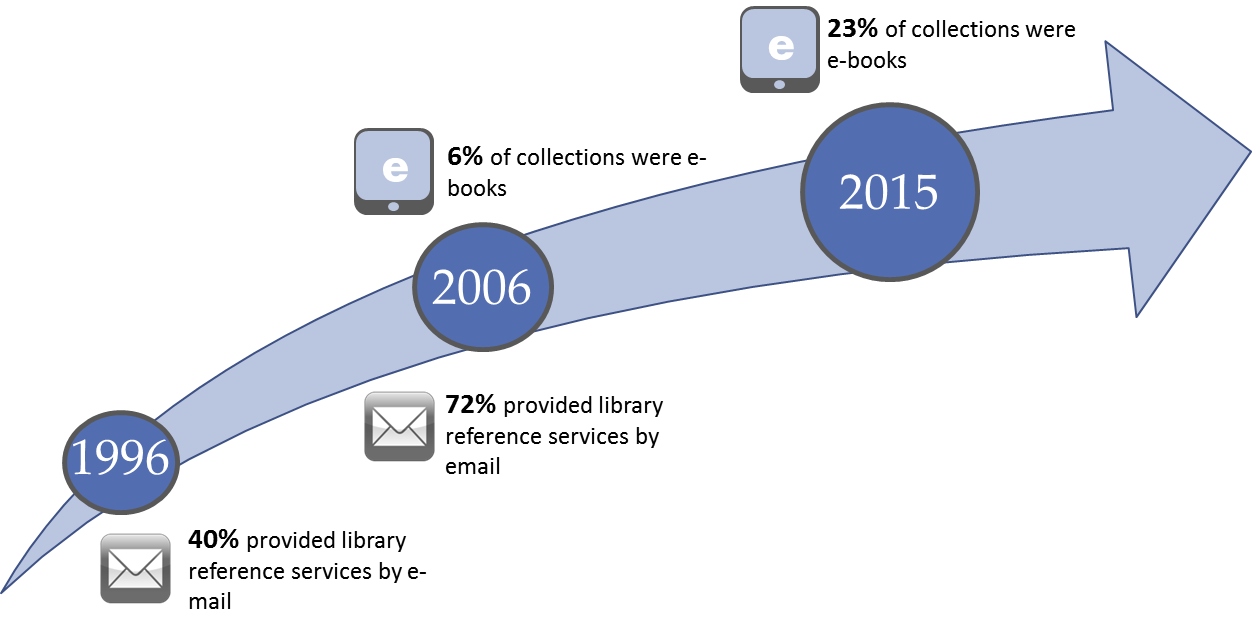By Christopher Cody and Bao Le
April is National Library Month! Did you know that NCES collects data on libraries?
While libraries have traditionally provided the public with a physical space for learning and accessing resources and information, the role of the library has expanded with advances in technology. With the dawn of the digital age, libraries have been working to meet the challenges of expanding access, learning opportunities, and overall public connection.[i] Academic libraries in particular, which are libraries located within postsecondary institutions, have embraced technological improvements, as shown in data collected by the National Center for Education Statistics (NCES).
The Academic Libraries (AL) Survey has a rich history at NCES, starting in 1966 when we began conducting the surveys on a three-year cycle as part of the Integrated Postsecondary Education Data System (IPEDS). The survey moved around a bit, but is now fully housed in IPEDS and is currently administered on a yearly cycle.
IPEDS’s AL Survey offers an abundance of data to track the advancement of libraries, including data on topics such as collections/circulations, expenses, and interlibrary services. These data show a clear progression of libraries into the digital age. Here are some highlights:
- In 1996, “80 percent of institutions with an academic library had access from within the library to an electronic catalog of the library’s holdings, 81 percent had internet access within the library.”[ii]
- In 1996, about 40 percent had library reference service by e-mail. Just 10 years later, 72 percent of academic libraries provided library reference service by e-mail or the internet.[iii]
- In 2006, only 6 percent of all academic library collections were e-books. By 2014-15, about 23 percent of all collections were e-books and 31 percent of the total library collections were from electronic and digital sources (e-books, e-media, and databases) as shown in Enrollment and Employees in Postsecondary Institutions, Fall 2014; and Financial Statistics and Academic Libraries, Fiscal Year 2014: First Look (Provisional Data).
- In 2014-15, postsecondary institutions housed approximately 1.1 billion items in physical library collections (books and media) and about 521 million items in electronic library collections (digital/electronic books, databases, and digital electronic media).
Image may be NSFW.
Clik here to view.
Over the past 20 years, libraries have evolved to ensure information is accessible to the public through the latest mediums of technology.
So in honor of National Library Month, take advantage of the abundant historical academic and school library data available through NCES located on the Library Statistics Program page. More recent academic library data can be accessed by visiting the Use the Data portal on the IPEDS website.
[i] Clark, L., Levien, R. E., Garmer, A. K., and Figueroa, M. (2015). Re-Thinking the Roles of U.S. Libraries. In D. Bogart and A. Inouye (Eds.), Library and Book Trade Almanac: formerly The Bowker Annual 2015, 60th Edition (pg. 3-22). Medford, NJ: Information Today Inc.
[ii] Cahalan, M. W., Justh, N. M., and Williams, J. W. (1999). Academic Libraries: 1996 (NCES 2000-326). National Center for Education Statistics, Institute of Education Sciences, U.S. Department of Education. Washington, DC.
[iii] Holton, B., Hardesty, L., and O’Shea, P. (2008). Academic Libraries: 2006 (NCES 2008-337). National Center for Education Statistics, Institute of Education Sciences, U.S. Department of Education. Washington, DC.